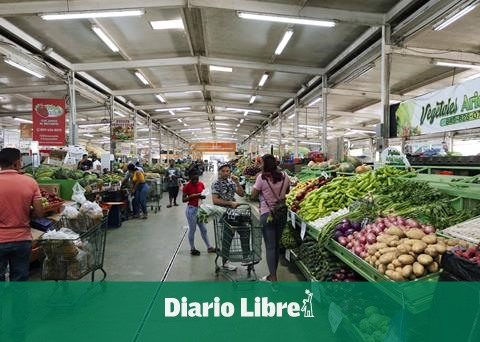The Central Bank of the Dominican Republic (BCRD) reported this Friday that the consumer price index (CPI) of the month of February registered a variation of 0.92% with respect to the month of January 2022. With this result, the inflation accumulated for the January-February period stood at 2.11%.
The monthly report of the BCRD indicates that the inflation interannual measured from February 2021 to February 2022 was placed at 8.98%, while the inflation annualized underlying stood at 6.97% in February 2022. This last indicator isolates the behavior of some foods with great variability in their prices, as well as the fuels, services with regulated prices such as the electricity rate and the transportin addition to the alcoholic drinks and the tobaccothus allowing clearer signals to be extracted for conducting monetary policy.
The report released by the BCRD explains that the dynamics of domestic prices continue to be affected by external shocks, mainly associated with new increases in the price of Petroleum as a result of the international uncertainty derived from the escalation of geopolitical conflicts that have limited the global production and supply of crude oil.
In particular, the price of Petroleum Texas Intermediate (WTI) was quoted above US$95 per barrel at the end of February, increasing from the average of US$83 registered in January 2022, and currently presents high volatility, trading around US$110 per barrel. It should be noted that the rise in the prices of fuels and ground transportation services accounted for 42% of the inflation registered in the month of February 2022.
Similarly, it details that the international prices of important primary food goods for local production, such as corn, wheat and soybeans have continued to rise in recent months, conditioned by a more turbulent external scenario and tensions in the markets where the negotiations are agreed. transactions of this type of raw materials. Likewise, the high cost of container transport and other disruptions in supply chains continue, which affects the prices of imported goods.
The report highlights that in this scenario, in order to mitigate the impact of the inflation imports on domestic prices in a context in which the real gross domestic product (GDP) has already exceeded its pre-pandemic level, the Central Bank of the Dominican Republic has significantly reduced liquidity levels in the financial system through open market operations and the use of the Electronic Currency Trading Platform, which is consistent with the accumulated increase of 200 basis points in the monetary policy rate within the framework of the plan to normalize monetary conditions.
It adds that these measures have moderated the rate of expansion of monetary aggregates and the money supply (M1)after having experienced notable year-on-year growth in the first months of 2021.
Currently, at the end of February 2022, its annualized rate of increase has moderated to 14.0% and it is expected that it will continue to decline to around 9.0%-10.0%, in line with the nominal GDP expansion that would be consistent with the potential growth of the economy and with the goal of inflation of the BCRD.
The document also explains that the Dominican peso reflects an annualized appreciation of more than 5% at the end of February 2022, which, together with the monetary normalization process, is helping to mitigate inflationary pressures of external origin and would facilitate the gradual convergence of the inflation to the target range of 4% ± 1% in the monetary policy horizon. In addition, the appreciation of the peso contributes to lower foreign debt service and reduces the cost of imports.
The monthly report on domestic prices highlights that the set of measures recently announced by the president of the Dominican Republic, Luis Abinader, particularly the subsidy for fuels to avoid new rises due to the increase in the price of Petroleum in international markets and the subsidy of up to 10% on inputs and raw materials for agriculture such as corn, wheat, soybeans, will contribute to the process of reducing the inflation in the coming months.
Likewise, the increase in direct social assistance through the Supérate program, the adjustment of the Bono Gas and the subsidized sales of food through the National Institute for Price Stabilization (Inespre) and the economic kitchens, will contribute to improving living conditions. the most vulnerable population at this juncture of inflation import through which we are transiting.
Variation by groups
The analysis of the governing body of monetary policy indicates that, in relation to the detail of the CPI by groups of goods and services, the most significant variations were registered in the transport groups (1.97%), miscellaneous goods and services (1.03%), food and non-alcoholic beverages (0.96%), restaurants and hotels (0.66%) and housing (0.65%).
It details that the growth of 1.97% in the transport index was mainly due to the increases experienced in the prices of regular gasoline (3.30%) and premium (3.56%), liquefied gas (LPG) for vehicles (2.40%) and diesel (4.33%). In addition, price increases were recorded in land transportation services by public car (1.02%), urban bus (1.60%), taxi (2.38%), motoconcho (0.74%), buses from private companies (5.68%), as well as such as automobiles (0.49%) and tickets abroad (2.97%).
Regarding the 1.03% increase in the price index for the miscellaneous goods and services group in February, it is mainly explained by the price increases in health insurance (9.31%), childcare services for children (4.82%), as well as in personal care services, such as men’s haircuts (1.07%), hair washing and styling (0.78%) and personal care items (0.62%).
The variation of 0.96% in the CPI of the food and non-alcoholic beverages group responds fundamentally to the increases in the prices of peppers (8.27%), cassava (5.17%), green bananas (2.27%), soybean oil (1.96% ), tart lemons (15.33%), fresh chicken (0.35%), avocados (6.87%), rice (0.43%), potatoes (3.83%), pork (1.49%), carrots (11.36%), evaporated milk (2.46%), fish (3.79%), purified water (0.82%), green bananas (2.09%), green pigeon peas (5.20%), passion fruit (11.61%), liquid milk (1.03%) while other food goods registered decreases in prices such as eggs (-2.43%), onions (-5.70%) and garlic (-3.80%).
The document explains that with regard to the variation of 0.66% in the CPI of the restaurants and hotels group, it is basically due to the increase in the prices of food services prepared outside the home, such as the dish of the day (0.64% ), the chicken service (0.70%) and food services with accompaniment (0.59%). It is pointed out that the increase observed in the price index of this group is a consequence of the price increases of the basic inputs for its elaboration, among them meats, oils, rice, beans, some groceries, breads, sausages, cheeses, gas, among others, which directly affect the final price of these food services.
While the variation of 0.65% of the housing group is explained practically in its entirety by the rise in liquefied gas from Petroleum of domestic use (LPG) in 2.40%, of housing rental services (0.17%), of housing maintenance services (1.07%) and door repairs (4.12%).
Inflation of tradable and non-tradable goods
The report establishes that when performing the analysis of the inflation According to the groups of tradable goods (those that can be exported and imported free of restrictions) and non-tradable goods (those that can only be marketed within the economy that produces them or are subject to measures that limit their imports), it is observed that the The CPI for tradable goods registered an increase of 1.37% in the month of February, while that for non-tradable goods grew 0.46%.
Inflation by geographical areas
The BCRD indicates that the results of the CPI in the different geographical regions showed that the variation of the CPI in the Ozama region, which includes the National District and the Santo Domingo province, was 0.81%, in the North region 1.03%, in the East region 0.98%. and South region 0.99%.
Inflation by quintiles
The BCRD reported that the behavior of the CPI by socioeconomic strata shows that quintiles with the lowest income registered variations of 0.82% in quintile 1, 0.90% in quintile 2 and 0.92% quintile 3mainly explained by increases in food prices, fuels, ground transportation services, personal care services, and meals prepared outside the home. As for the quintiles with the highest income (4 and 5), they registered rates of inflation of 0.91% and 0.96% respectively, largely due to the rise in prices of fuelsautomobiles and air tickets within the transportation group.















